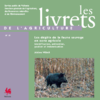[article]
| Titre : |
Ungulates increase forest plant species richness to the benefit of non-forest specialists |
| Type de document : |
Imprimé |
| Auteurs : |
Vincent Boulanger ; Jean Luc Dupouey (1958-) ; Frédéric Archaux ; Vincent Badeau ; Christophe Baltzinger ; Richard Chevalier ; Emmanuel Corcket ; Yann Dumas ; Françoise Forgeard (1949-) ; Anders Marell ; Pierre Montpied ; Yohann Paillet ; Jean-François Picard (1944-) ; Sonia Saïd ; Erwin Ulrich |
| Année de publication : |
2018 |
| Article en page(s) : |
485-495 |
| Langues : |
Français (fre) |
| Catégories : |
[CBNPMP-Thématique] Biodiversité
[CBNPMP-Thématique] Forêts (habitat)
[CBNPMP-Thématique] Autoécologie (relations/interactions individus-espèces)
[LOTERRE-Biodiversité] Relation animal-végétal
|
| Résumé : |
Large wild ungulates are a major biotic factor shaping plant communities. They influence species abundance and occurrence directly by herbivory and plant dispersal, or indirectly by modifying plant-plant interactions and through soil disturbance. In forest ecosystems, researchers’ attention has been mainly focused on deer overabundance. Far less is known about the effects on understory plant dynamics and diversity of wild ungulates where their abundance is maintained at lower levels to mitigate impacts on tree regeneration. We used vegetation data collected over 10 years on 82 pairs of exclosure (excluding ungulates) and control plots located in a nation-wide forest monitoring network (Renecofor). We report the effects of ungulate exclusion on (i) plant species richness and ecological characteristics, (ii) and cover percentage of herbaceous and shrub layers. We also analyzed the response of these variables along gradients of ungulate abundance, based on hunting statistics, for wild boar (Sus scrofa), red deer (Cervus elaphus) and roe deer (Capreolus capreolus). Outside the exclosures, forest ungulates maintained higher species richness in the herbaceous layer (+15%), while the shrub layer was 17% less rich, and the plant communities became more light-demanding. Inside the exclosures, shrub cover increased, often to the benefit of bramble (Rubus fruticosus agg.). Ungulates tend to favour ruderal, hemerobic, epizoochorous and non-forest species. Among plots, the magnitude of vegetation changes was proportional to deer abundance. We conclude that ungulates, through the control of the shrub layer, indirectly increase herbaceous plant species richness by increasing light reaching the ground. However, this increase is detrimental to the peculiarity of forest plant communities and contributes to a landscape-level biotic homogenization. Even at population density levels considered to be harmless for overall plant species richness, ungulates remain a conservation issue for plant community composition. |
| Lien pérenne : |
DOI : 10.1111/gcb.13899  / HAL : hal-01592230 / HAL : hal-01592230  |
| Permalink : |
https://biblio.cbnpmp.fr/index.php?lvl=notice_display&id=147963 |
in Global Change Biology > 24 (2) (02/2018) . - 485-495
Boulanger, Vincent, Dupouey, Jean Luc (1958-), Archaux, Frédéric, Badeau, Vincent, Baltzinger, Christophe, Chevalier, Richard, Corcket, Emmanuel, Dumas, Yann, Forgeard, Françoise (1949-), Marell, Anders, Montpied, Pierre, Paillet, Yohann, Picard, Jean-François (1944-), Saïd, Sonia, Ulrich, Erwin
2018
Ungulates increase forest plant species richness to the benefit of non-forest specialists.
Global Change Biology, 24(2): 485-495.
|


 Affiner la recherche
Affiner la rechercheLes dégâts de la faune sauvage en zone agricole identification, prévention, gestion et indemnisation / Jérôme Widar (2011)

 Consultable
Consultable Consultable
ConsultableUngulates increase forest plant species richness to the benefit of non-forest specialists / Vincent Boulanger in Global Change Biology, 24 (2) (02/2018)

/ HAL : hal-01592230
 Consultable
Consultable


